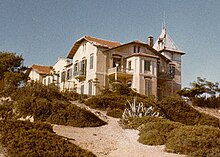Limenaria
Limenaria ( Greek Λιμενάρια ( n. Pl. )) Is a place with 2,480 inhabitants (2011) on the southwest coast of the Greek island of Thasos . The mountain village of Kastro (9 inhabitants) also belongs to the Limenaria community .
The place is located in the southwest of the island and is now the second largest city on Thasos. It has a harbor protected by a 220 m long pier, a 400 m paved promenade, the Parelia, an elementary school, a grammar school, post office and two banks, churches and chapels and a large selection of taverns, ouzeries and shops. Since the end of mining in the mid-1960s, tourism has increasingly come to the fore as an economic factor in the town and is now the main source of income. New hotels have been built, especially in the west of the city and in the Trypiti district there. Limenaria has been connected to the capital Limenas by the well-developed ring road since 1972 on both the west and east routes. The boat traffic from Limenaria to Kavalla with the Papageorgiou brothers' Synginonia, which was regulated in the 1950s and lasted 3 ¼ hours in calm seas, was reduced to 1 ½ hours in the 1960s with the ship Papageorgiou II . The connection no longer exists today.
The local cultural association, To Kastro , offers extensive and interesting annual programs. The industrial culture project launched in 2000 to restore the abandoned mining operations, the building and the metallurgical facilities in the Limenaria area , also known as the Geopark , was an ambitious project in the tourism sector . Funds from the European Union totaling € 600,000 were acquired. The IGME was responsible for carrying out the work . On September 16, 2005, the status of the project was presented to the public in the back garden of the Palati by representatives of the authorities and the IGME. After the work was stopped, the restoration of the building was far advanced but not complete. A project control and final acceptance by the co-financing EU did not take place. Since then, serious damage to the building has occurred as a result of poor workmanship or incomplete securing. The result of the profitability of the Geopark project, which claimed about half of the EU funds acquired, was not disclosed to the public. The project must be viewed as a failure.
history
In the immediate and nearer area of today's location there are important early settlements and mines:
- Rotocker mines Tzines and Vaftochili from the Upper Paleolithic, 5 km north of today's Limenaria
- Settlement from the Neolithic, in today's center
- Paliokastro settlement from the Early Iron Age, 4.5 km northwest
- Copper mines and smelter sites Koumaria, Agios Elephterios, Koupanada, Kokikini Petra, Vouves from the 8th century BC. BC to the 10th century AD, 2 to 5 km north to northeast
- Lead / silver smelting of Skres and Metallia from the 5th century BC BC to 10th century AD, 1 or 5 km east
- Iron ore smelting Vambakies , 3 km southeast
Limenaria is not mentioned in the early Greek history of the island. There is also no evidence from Ottoman times. Alexander Conze , one of the early travelers , described the current location of Limenaria in 1858 as an olive and wine-planted plain of the Skala of the village of Kastro, which itself is three hours up the valley . However, he mentions the fact that the residents of Kastro have built huts (καλύβες) and a church in honor of St. Georgios here, in whose place the whole place will relocate and leave its current place in the mountains desolate with continued security from piracy . From this it can be concluded that the nucleus of the place lies in today's northern suburb of Limenaria, in Kalyvia. The feast of St. Georgios is celebrated here on the Tuesday after Easter.
At the end of the 19th / beginning of the 20th century , the population settled in the mountain village of Kastro moved to the coast and founded today's Limenaria near Kalyvia as the youngest coastal town on the island, called Hamedie (Χαμεδίε) under Turkish rule .
In 1903 the place Limenaria experienced a considerable boom through the establishment of the Speidel factory . The construction of the plants, buildings and the ore transport facilities on the eastern edge of Limenaria, the opening of the Vouves opencast mine only 2 km away and the operation of the company have promoted the development and prosperity of the place for a large number of employees for over 11 years. With the beginning of the First World War, the factories have to close. In 1925, the facilities destroyed in the war were rebuilt and resumed to the same extent by the SAMM (Vieille Montagne) based in Limenaria and continued for another 8 years. Under the owner Friedrich Krupp , the SAMM finally mined iron ore from the nearby open-cast mines of Koumaria, Platania and Koupanada from 1955 to 1964 and shipped them via the Metalliabucht.
Individual evidence
- ↑ Results of the 2011 census, Greek Statistical Office (ΕΛ.ΣΤΑΤ) ( Memento from June 27, 2015 in the Internet Archive ) (Excel document, 2.6 MB)
- ↑ A. Conze: Journey on the islands of the Thracian Sea , Hanover 1860, p. 35/36
Web links
Coordinates: 40 ° 38 ' N , 24 ° 35' E



